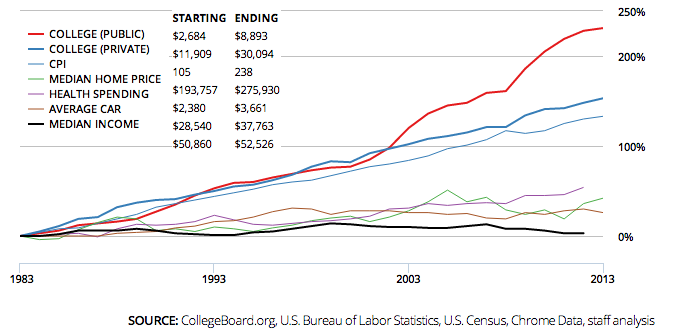People are always telling parents to put away money for their children’s college education, especially with the cost of college rising so quickly over the past two decades.
But it’s not always easy.
Between the mortgage, car payments, and other expenses, many parents find it nearly impossible to save money for college. And most aren’t even sure how much to save, especially when they’re trying to save for retirement at the same time.
With the cost of college topping $60,000 at some schools, it may seem impossible for regular families to afford higher education.
But there are still plenty of quality colleges for half the cost. Kiplinger recently released a list of the best value colleges that still cost under $30,000 per year, all of which provide a great bang for your tuition buck.

Everyone knows college costs are up, but how does that rise compare to the increase in prices of other life purchases, like cars, housing and consumer goods?
This chart shows how the rise in college tuition at public and private universities compares to the increase in cost of items in the consumer price index (CPI), homes, cars, and healthcare as well as the median income.

We’ve written extensively how college costs, both public and private, have risen dramatically over the past two decades and continue to rise each year.
While nearly every college has raised tuition, some have increased much more than others. The charts from Quartz rank public and private colleges by the largest tuition increases in 2014 US dollars, after adjusting for inflation.

While we believe you should major in a subject you enjoy because you’ll do better if you’re interested in the material, there’s no denying that some college majors pay better than others–usually because students in these positions gain more specialized, in-demand knowledge.
According to a new study from Michigan State University, electrical engineering majors have the highest starting salaries out of college, with the average graduate making $57,030 in the first year.

We’ve expressed that the value of your college degree is influenced heavily by several factors, including choice of major and how much debt you take on to pay for it.
And now a new calculator from The Hamilton Project makes it easier for college-bound students to understand how much their degrees will cost them over time depending on major, student loan debt, interest rates, and term of the loan.
With the cost of college rising, more parents are beginning to look at the return on investment of where they send their children to college and evaluating whether schools are worth their high costs. As College Financing Group co-founder Andy Leardini told Buffalo Business First in a recent article, the college decision has become like […]
Four years at college is pricy enough, with the average cost of one year at a 4-year private university topping $40,000 and $18,000 at public universities. Over the course of four years, those costs really add up. But the majority of American college students doesn’t even finish their degree in that time, according to a new report […]

If you’re looking to go out of state for college but don’t want to spend the money on a private college, considering some low-cost public colleges is a great idea. Depending on where you live, you may find that these colleges are even cheaper than a public college in your own state.
Check out the list below from U.S. News for the top 10 colleges in the United States with the lowest tuition for out-of-state students. They may not be as well-known as some of the bigger-name schools, but they can provide a quality education at an affordable price.
As parents of college-bound students know, applying to college is more than a financial decision–it’s an emotional one as well. Our founders Rick Ross and Andy Leardini recently appeared on Winging it! Buffalo Style to discuss the challenges families and students face when choosing a college and figuring out how to pay for it. Taking the emotion […]